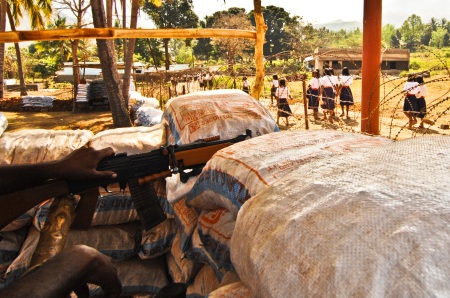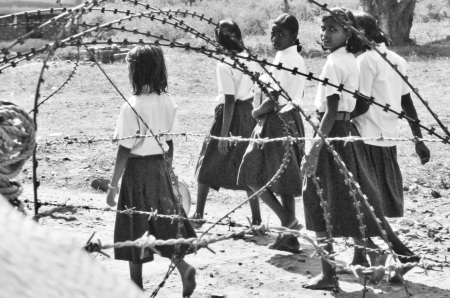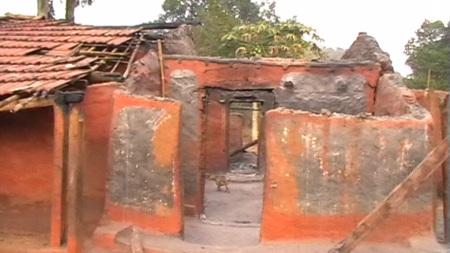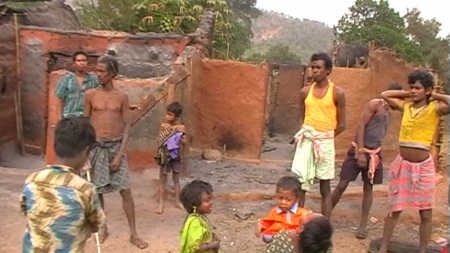
Narayanpatna: Movement On The Run
February 5, 2011
This article appears in The New Indian Express on the 6th of February, 2011.
‘Nachika Linga’s owner’s house used to be this one,’ Says the Border Security Force commander, regarding the newest BSF camp set up at Podapadar village, one of the flashpoints of the Chasi Mulia Adivasi Sangh movement. The house in question belonged to Nila Kancha Parida who literally owned Nachika Linga – a bonded labourer on his own land who used to earn Rs.5 per month, eventually a leader of a tribal movement, and now, one of the most wanted people in Narayanpatna block. It is literally petty symbolism that the once-oppressor’s house is now used by the Border Security Force to track down members of the Chasi Mulia Adivasi Sangh, who stood up for their land rights in 2009.
Today, their entire movement has gone underground, over 150 of their members and their supporters are in jail, including Gananath Patra, of the CPI (ML), who was arrested as a Maoist, as well as his associate Tapan Mishra, who has already clashed with officials in the prison after going on numerous hunger strikes. Yet the vast majority of the CMAS live in fear further within the jungles, often on the move, without food, in constant risk of being apprehended.
Nevertheless, six Kondh tribal women and four infants had gotten onto the Hirakhand Express at Koraput railway station on the 25th of January 2011 to travel to Bhubaneshwar. For many of them it was the first time on a train. There was never any need to go to Bhubaneshwar, or anywhere beyond their jungles in Narayanpatna or Laxmipur before. But secretly, and quietly, these six women travelled to Bhubaneshwar, and were told that they would have to testify at a public hearing, to the National Human Rights Commission.
All six women have lost their husbands to state violence.
Balsi Kendruka w/o Andru of the village of Baliaput, Narayanpatna lost her husband on the 20th of November firing/’camp attack’.
Sonai Kendruka w/o Singana of the village of Podapadar, Narayanpatna lost her husband on the 20th of November firing/’camp attack’.
Kamla Tadingi w/o Ganguli of the village of Bagam, Narayanpatna lost her husband when he was picked up by the police in Narayanpatna, and died in custody in Koraput Jail on the 12th of April 2010.
Kamla Sirika w/o Ratna of the village of Siriguda, Narayanpatna lost her husband when he went for treatment for an unspecified illness to Narayanpatna town, and was arrested by the police and died in a hospital in Berhampur on the 8th of June, 2010.
Saibo Honika w/o Jimme of the village of Jogipalur, Narayanpatna lost her husband when the security forces raided her village. He was allegedly drowned in Janjawali river.
Singaru Huika w/o Katru of the village of Talameting, Laxmipur was shot dead by the security forces the day after the Maoists had raided the nearby NALCO plant where they killed ten CISF jawaans and lost four of their own on the 12th of April 2009. Katru Huika is suprisingly even mentioned as a ‘public witness’ in the FIR filed regarding the NALCO attack.
And the women barely spoke at the hearing.
The irony is that K G Balakrishnan, chairman of the NHRC returned to Delhi a day before the hearing. (The bigger irony was that he would have been sharing the dias with the senior advocate Prashant Bhusan who, along with his father, had indicted him as one of the ‘eight corrupt Chief Justices of India’),’ in a now-famous affidavit.
The hearing itself indicted the government of Orissa regarding ‘state repression on the rise in the state particularly on people’s movements against displacement and land grabbing.’ As for the recent spate of encounters in Bargarh, Keonjhar, Jajpur and Rayagada, it had called for ‘an independent and impartial investigation’.
The Way Of The Gun

Since the firing on the 20th of November, 2009, still widely considered to be a ‘camp attack’ by the police and the administration, all that the Kondh adivasis of Narayanpatna have seen is the slow militarization of their lives. Not only have three BSF camps been set-up in Narayanpatna block, but Maoist activity has also been on the rise. There had been one IED blast that claimed four civilian lives in January 2010, and since then there have been numerous IEDs recovered by the police in regular intervals. Just recently another IED exploded on the 11th of January, 2011 near Jogi Palur, injuring three government officials.
There have also been a series of killings by the Maoists in August of 2010, most infamously, of Anand Kirsani, the leader of the embryonic state-backed anti-CMAS group, the Shanti Committee, who was also a Zilla Parishad member and a Congress party leader. The Maoists also killed a member of the CPI (ML), Arjun Kendruka as an informant. Another villager, Ghasi Kendruka from Gotiguda village was killed on the 15th of August. The General Secretary of the CPI (Maoist) Ganapathy himself has stated in a recent interview about the gains made by his party in Narayanpatna block, and against the ‘revisionist’ tendencies of other members of communist parties working in both Narayanpatna and Bandhugaon block. And there has been no secret that the Bandugaon movement and the Narayanpatna movement have been at odds over the last two years.
And yet the core issue remains land.
While the Shanti committee has been ‘finished’ after the murder of their leader Anand Kirsani, there is still no gaurantee that the paddy that rightfully belongs to the tribals would not be illegally split 50-50 between the tribals and the non-tribal Sahukars and ‘landlords,’ as had happened last year, after the suppression of the Chasi Mulia Adivasi Sangh.
Cultivation is taking place in many of the strongholds of the Chasi Mulia Adivasi Sangh at Narayanpatna, and yet the BSF presence is ominous. On the 27h of January itself, reports emerged that 6 homes in Musalmanda village of Narayanpatna were allegedly burnt down by the security forces.
Images from a video capture of the burning of the homes of Narayanpatna. Courtesy – Source.



A Soldier’s Crisis
‘You know what would solve this whole Maoist problem?’ Asks a BSF commander, ‘There should be mandatory military service in either the CRPF or BSF by all citizens of India. This way some politician’s son can also end up at Podapadar.’
The imaginary border is drawn across the jungles, cutting across mainstream India and that which belongs to the Kondh of the Chasi Mulia Adivasi Sangh at Podapadar. The Border Security Force is once again strategically isolated as most security camps within the jungles are. A school functions a few metres from the camp, and hillocks surround the camp.
‘If we’re attacked, we’re on our own,’ Said the commander, ‘And we had asked for another spot, but they gave us this one.’
And the risks don’t stop there.
‘You don’t even have to ask us about mosquitoes,’ Said a BSF soldier, laughing, who mentions there have already been a handful of malaria cases in the camp.
Yet what remains striking is that the BSF soldiers were aware of the existence of bonded labour at Narayanpatna block. ‘Five generations of Nachika Linga were slaves.’ Mentions the BSF commander, yet the manhunt against him continues.
No one in Narayanpatna ever forgot the ‘dead or alive’ posters of Nachika Linga that were posted across the town.
Posted in Agriculture, Chidambaram, Combing Operation, Custodial Beating, Displacement, Forest Rights Act, Human Rights, Kondh, Land Rights, Maoists, Narayanpatna, Orissa, Police inaction, Poverty, Resistance, Right To Food, Tribal Rights |
Leave a comment